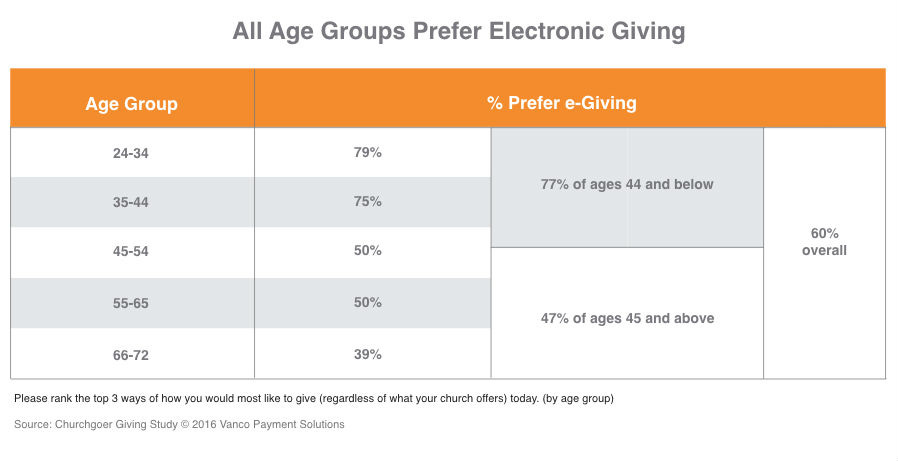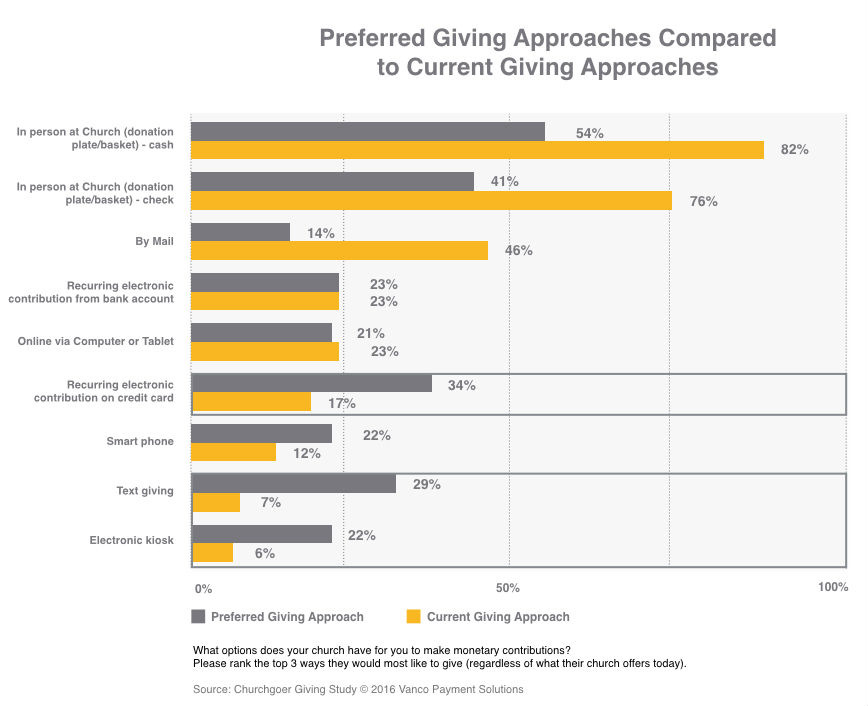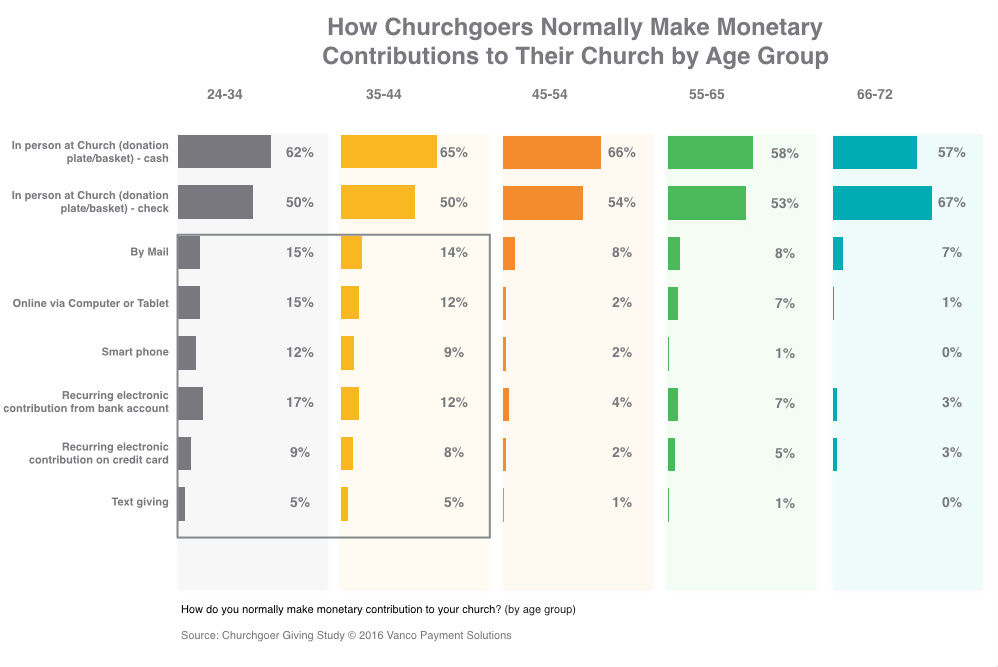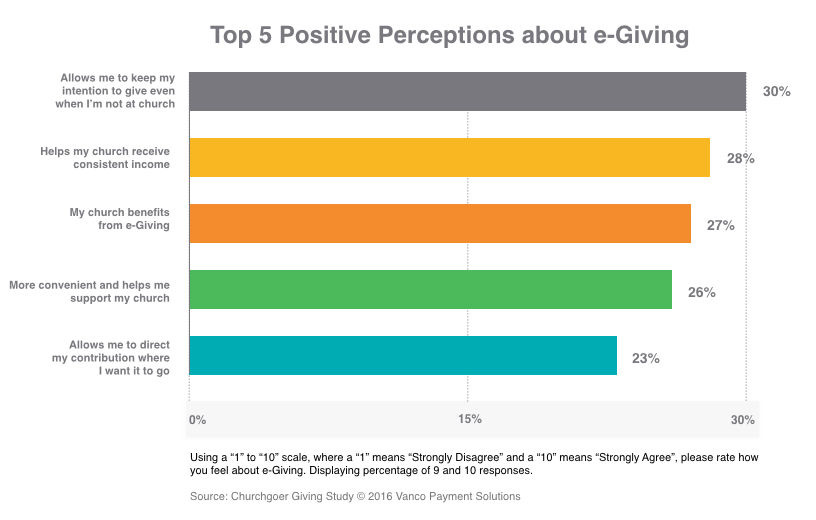Vanco Study Reveals Most Engaged Church Members Want E-Giving
Note: This post is based on an interview I had with Kevin Lee, CEO of Vanco Payments, following a study they released about church members, church leaders, and their orientation toward e-giving. If you don’t already have it, you can download it now. I’ve written about church giving for years. Finally, the opinions and ideas expressed in this post are mine. Basically, if I say something that upsets you, blame me not Kevin or Vanco Payments.
There are a lot of assumptions leveled from the pulpit to the pew about church giving. One very important one is the ongoing debate around electronic giving and whether or not it has a place in the life of the local church and the discipline of worship and generosity.
SERIOUSLY. IT’S 2016. CAN’T WE JUST AGREE THAT E-GIVING IS HERE TO STAY?
It is astonishing to me that we are still talking about why “we should” or “should not” offer e-giving options to church members and visitors who would like to financially contribute to the work and ministry of a particular local church. Yet that very conversation is still alive and well in many churches today.
The very resistance to this trend is, in my opinion, unfounded. It stems more from convenience of the church leader who doesn’t want to be “bothered” by new technology while he or she pays their bills online, uses a debit card to pay for dinner, and even makes charitable contributions to other nonprofits online.
EVERY CHURCH LEADER HAS THEIR REASONS. HERE ARE SOME OF MY FAVORITES I’VE HEARD OVER THE YEARS:
“Only young people giving electronically, and our church doesn’t have very many young people.”
“If we offered e-giving, it would immediately cost us three percent (or whatever the transaction fee is) to our church budget.”
“I’m not sure e-giving is as worshipful of an experience as giving with a church in an offering plate.”
“We’re a small church, and e-giving is just too complex for us.”
LET ME REVEAL MY BIAS: IT IS NOT THE JOB OF THE CHURCH LEADER OR GOVERNING BODY TO DETERMINE WHAT METHODS OF GIVING ARE “ACCEPTABLE” OR NOT.
Giving is an emotional response to an inward commitment. Therefore, it is the job of the church leader to remove obstacles to those who are exhibiting behavior of a fully engaged disciple. While giving is not the only mark of that, it is certainly an external, tangible, and measurable action that flows from God-inspired movement within an individual.
Believe it or not, the very act of giving has inspired those with no faith to find one and those with faith to inspire new levels of spiritual growth and transformation. There is a reason that the Jesus of the Gospels is recorded more often talking about money than even sin and salvation in the New Testament.
We wouldn’t tell someone who has expressed an interest in reading the Bible or praying that they can only read certain translations or pray in specific ways. Of course not! We would encourage them to start where they are comfortable and develop a habit of doing both over time. The same should be true about church giving.
IT’S TIME TO MOVE BEYOND THE CONVERSATION OF “IF” AND MOVE TOWARD “HOW.”
Vanco summarized a key finding that tips the hat of the attitude and posture church leaders should have toward church giving on page four of the study. They write:
“Churchgoers who are most engaged with their churches also have stronger preferences toward electronic giving:
Churchgoers who are most engaged with their churches, taking part in multiple activities per week, want e-Giving the most. Almost 800 of those surveyed participated in at least two or more church groups or activities, including worship services, and of those up to 80 percent preferred e-Giving.”
There you have it. The most engaged church members, not just those on the fringe, prefer to have the option to give electronically. This debunks the myth that it’s just young people and those who give sporadically or randomly are the ones who use e-giving methods.
KEY FINDING: E-GIVING USERS ARE NOT LIMITED TO THOSE UNDER 40 YEARS OF AGE.
Overall, Vanco discovered that 60 percent of those surveyed had a desire to give electronically. I’m impressed that 39 percent of those in the age group 66-72 expressed e-giving as one of their top three giving method preferences.
I believe what we are observing is how cultural trends of electronic banking and payments has become normalized. Even those who were not born into the electronic revolution are adopting lifestyles that involve digital payments.
Action: Stop projecting your personal preferences onto your congregation. It wouldn’t matter if I liked a paperback version of my Bible and you liked a leather-bound edition, would it? Of course not! The fact that one is in use is the point. The same should be extended to methods of giving. If someone want to give to your church, don’t create obstacles. Instead, eliminate barriers.
KEY FINDING: THERE IS A DISCREPANCY BETWEEN PREFERENCES OF THOSE WHO GIVE AND THE OPTIONS THE CHURCHES THEY SUPPORT OFFER.
It is amazing to me when you look at the graph above to discover the inverse relationship between preferred giving methods and available giving methods. It’s sad really. Why do we have to create discomfort in the giving process? It seems simple and easy to me.
More disconcerting to me is the complete disregard for the giving method preferences of those who fund the ministry itself. It would seem reasonable to me to pay attention to the cues church members are sending their leadership and that the leadership would react in kind. But that is clearly not the case.
This is a dangerous game for church leaders to play. The more they ignore electronic giving, the easier it becomes for church members to support other organizations because it’s easier and more accessible.
Action: Survey your church membership to determine what electronic giving methods they might prefer. Then experiment and see what happens. Churches have adapted their styles and approaches over time as the community and culture have shifted. That doesn’t suggest church leaders wane on the core convictions of their faith. But one giving method is not more “holy” than another.
KEY FINDING: ELECTRONIC GIVING IS CRITICAL FOR A DECENTRALIZED WORLD WHERE WE DON’T ATTEND CHURCH IN THE SAME GEOGRAPHIC LOCATION AT THE SAME PREDETERMINED TIME EVERY WEEK.
There is so much about our life that we conduct online today. It’s baffling how many church leaders have consistently ignored or purposefully delayed their adoption of electronic giving. Let me let you in on a little secret: no one else is debating whether or not electronic giving is an acceptable form of giving. That debate was resolved years ago. It’s time to recognize that we should encourage people, especially those most engaged with our church, to experience their journey of generosity and stewardship through a diversity of methods.
It’s easy to think that electronic givers never use checks and people who give using checks would never use electronic giving. Such is simply not the case. Take music for example. It’s possible to still own a record of your favorite album and yet still listen to it digitally through your smartphone. One isn’t better than the other. It’s simply not practical to have a turntable in your car.
The same is true when it comes to electronic giving. Multi-channel giving is here to stay. I want to give systematically and sporadically in ways that fit my lifestyle. No church leader or leadership body should make that decision for me.
Action: Stop assuming electronic giving is some kind of cop-out. Faithful givers want a variety of options. It’s the job of the church leader to help people grow in generosity, not prescribe the method of giving. You can fix this deficiency in your church before next Sunday. Get moving!
ACTION REQUIRED: WHAT’S YOUR NEXT MOVE?
The truth of the matter is that every week your church avoids electronically giving costs you money. A church is no different than another other nonprofit in that it is a membership-based organization that depends on the freewill offerings of a broad base of supporters to fund the programs and accomplish its mission. The difference is the eternal dimension of churches.
Perhaps the reason why books like, Passing the Plate, appropriately coin the American Christians’ attitude toward church giving as a “discretionary obligation” is because there persists lack of connection to reality many church leaders have when it comes to giving, particularly giving methods. It’s time to give up the fight for giving “purity” and eliminate the unnecessary complexity of traditional giving methods.
This is not a moral debate about which giving methods are superior to another. That’s a futile discussion and position to hold. Rather, this is an opportunity to meet people, especially your most engaged people, right where they are and allow them to be faithful in their support to the church in which they call “home.”
What you do next is critical to your ability to sustain and fund your ministry moving forward.
How has your church incorporated electronic giving into its culture and practice?





